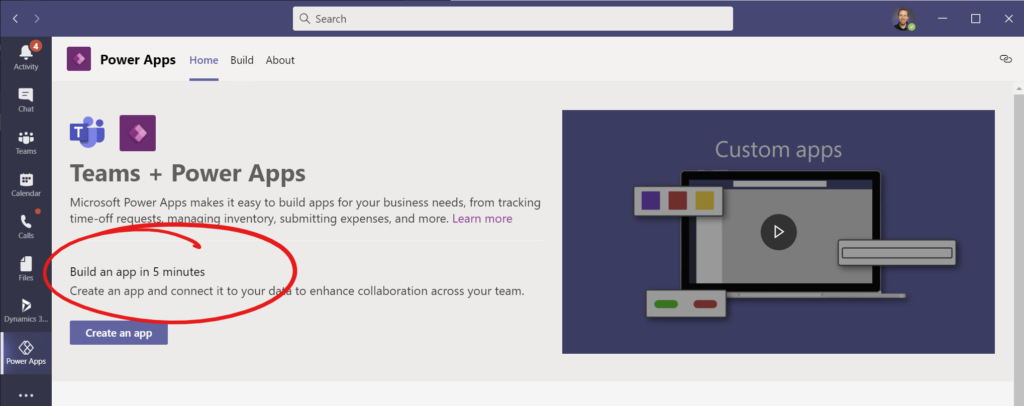Dataverse is Shadow Infrastructure
If you’re working with Microsoft today in any way, your long-term plan needs to include a strategy for Dataverse (previously called Common Data Service.)
This is true even if you have absolutely no plans to work with Microsoft Dynamics or the Power Platform. With 115 million users, Microsoft Teams appears to be the current best path through which Microsoft intends to deploy Dataverse into your organization.
Recently, a new tab called “Power Apps” became easily available for Teams users to create small apps based on the Dataverse backend. (They called it Project Oakdale until sometime last month.) This feature promises the ability for users to “Build an app in 5 minutes,” and in many use cases it will perform the job well for what the user needs.

As an administrator, if you don’t allow access to this feature, some team will decide to build shadow infrastructure either through a trial instance or some other hole in the wall because they’ll be convinced its the right tool for the job. A year later when everything shuffles around, you’ll find this app has landed on your doorstep with all of the expectations despite the fact that you never even intended to use this product. Worse, you’ll be in charge of an app that comes with none of the planning to make owning it easier.
This will happen dozens of times in small teams throughout your organization until eventually you’ll have to develop an official policy on Dataverse.
But at that point, you’re going to have 14 different versions of how business data is stored and no documentation on what information is stored within each silo. You’ll be running on the cloud in a disorganized mess, tempted to blame Microsoft for pushing this product through the door even though you didn’t want it. However, the users are right to find tools that work.

Even if you don’t want to use Dataverse, some team is going to decide that it’s the right solution to a problem they’re having.
If you look at the steps they’re taking, Microsoft’s grand vision is clear. Every Microsoft product you use will one day have a Dataverse connection that makes it easy for users to build working tools to connect it all.
Today it’s Microsoft Teams. Tomorrow, it’s Outlook, Word or Excel. Then, because it’s so easy to integrate, you’ll start to need support for some form of Dynamics. Before you know it, you’ll be spending most of your time trying to translate data between different silos without the help of any of the original team members who formed the original ideas about what each of these different implementations would do.
The reason this will happen is because the tools are finally good enough. They aren’t perfect. But they get the job done and it’s easy enough that your new hires are going to bring the knowledge of how to leverage this with them.
You can fight it, but because of the actual value this platform can bring, (read this with appropriate bias given the nature of our business) disabling access and usage of the Power Platform may come with significant opportunity costs.
What does a strategy for Dataverse look like?
We’re a Microsoft partner. We’re supposed to tell you to build your entire infrastructure on top of Dataverse and rely on Microsoft (and us) to take care of you. This is a perfectly valid path and many companies are finding success with this.
But this is not the only path. Your other systems and home-grown software may be your organization’s single source of truth and that isn’t going to change because Microsoft offers a new thing.
The good news is that there are good tools to get your data OUT of Dataverse. This is likely to continue to be the case unless Microsoft thinks they can extinguish the outgoing data streams. (My gut says that won’t happen.)
Your strategy should encompass the shape and schema of your data, regardless of where you’re storing it.
As your data strategy already includes this basic schema, you can get by with a version of this schema in an “official” Dataverse environment. With just this as a start you can provide clear instruction when users begin to explore the Dataverse so that their apps are at least putting the data in a place where you know to expect it.
Without a strategy, it’s easy to blame the tools for the problems you’ll see within your organization. But, we believe an appropriate strategy of growth means you don’t always get to choose what the smart people in your organization are doing. It’s much better to let them run while providing a path that minimizes anticipated future pain.
Don’t let Dataverse show up as an unanticipated pain in your organization. Its fingerprints are already visible in everything Microsoft is producing today.

